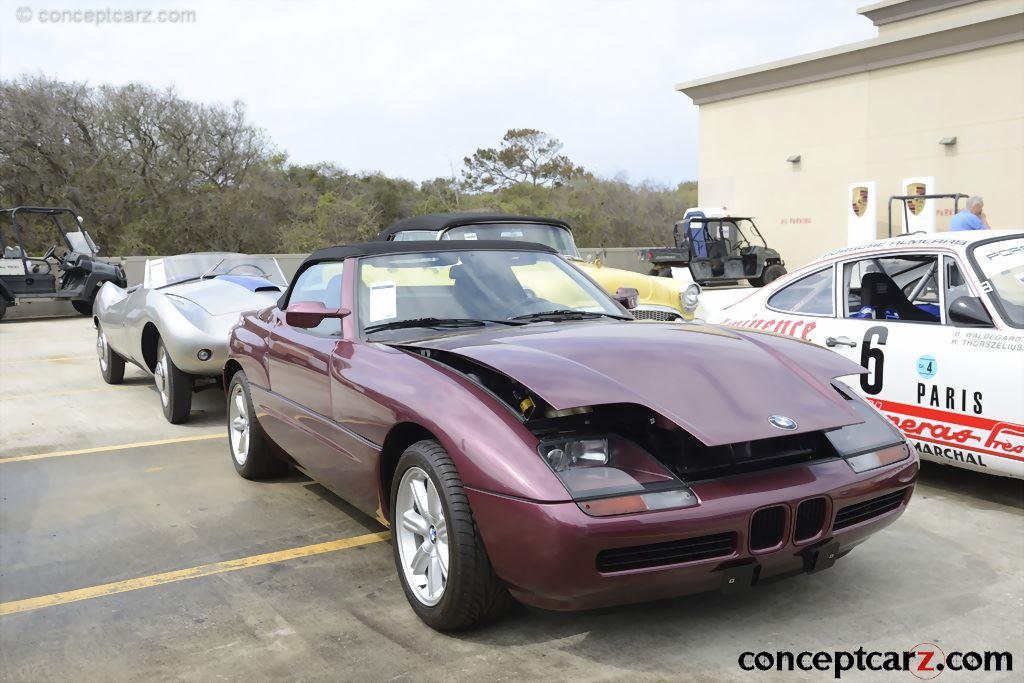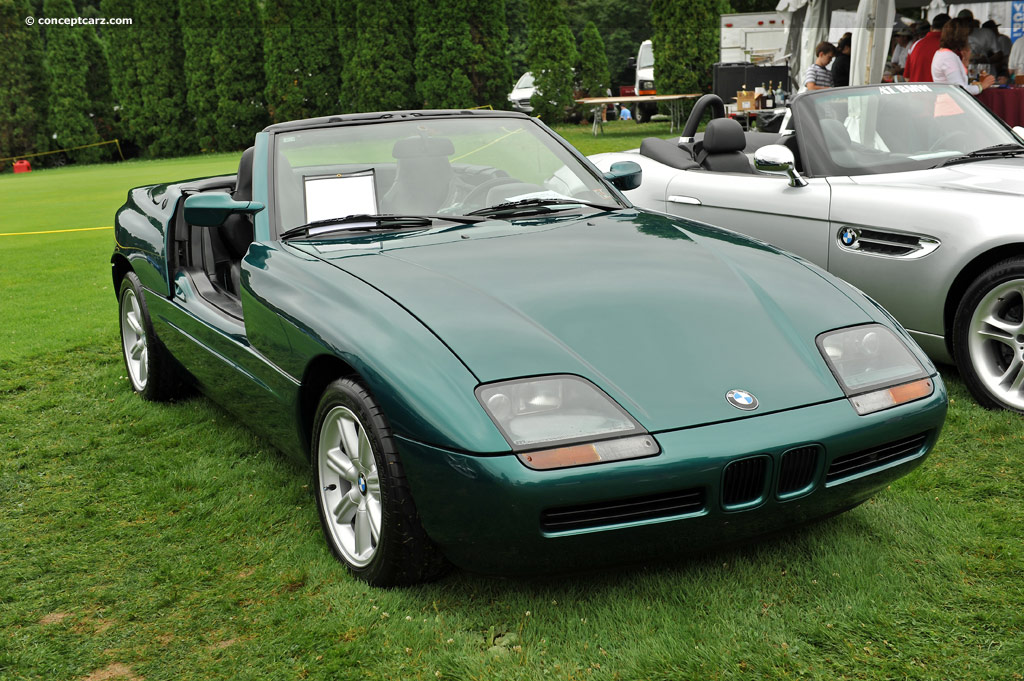When the BMW Z1 was shown in concept form at the Frankfurt Motor Show in 1987, it signaled the direction that future 'Z' cars would take. 'Z' in Z1 stands for 'Zukunft' or future in German, and its futuristic two-seater roadster shape was penned by Harm Lagaay. Production commenced in March 1989 and continued through June 1991. Inspired by its ancestorial predecessor, the 507, demand was initially so strong that 5,000 orders were placed even before production began. The Z1 featured doors that dropped down into the door sills. The chassis was specially designed for the Z1 and featured a number of innovative features such as removable body panels, continuously zinc welded seams, a composite under-tray, and unusual dropped doors.
Roadster
Chassis #: WBABA91000AL06826
View info and history
Auction entries : 1During its production lifespan, a total of 8,000 cars were produced, and all were left-hand drive. Most were sold in BMW's native German market (6,443 units). The 'Z' line that followed included the Z3, Z4, and Z8.BMW Z1 Development
BMW established the BMW Technik GmbH division in 1985 to develop new technology and concepts. Ulrich Bez served as the director of BMW Technik GmbH and oversaw the development of the Z1. When Bez left BMW in October 1988, Klaus Faust was placed in charge. Harm Lagaay served as the lead designer.BMW Z1 Body Design
The design of the BMW Z1 incorporated a flat undertray, a roll-hoop integrated into the windscreen surround, continuously zinc welded seams, and removable plastic body panels. BMW stated that the body could be completely replaced in 40 minutes, and the company suggested that owners acquire an additional set of body panels and change the color of the car from time to time.
RoadsterThe flat plastic undertray was used for ground effect aerodynamics. The aerodynamically shaped muffler and the rear bumper were designed to help reduce rear lift. The overall drag coefficient of the BMW Z1 was 0.36 Cd with the top up or 0.43 Cd with it down.Among the most visually unique features were the doors that retracted vertically rather than the traditional designs which swing outward or upward. (The Kaiser Darrin of 1954 was the first car to use retractable doors.) The Z1's door design allowed for hill sills which offered crash protection independent of the doors. Electric motors controlled the windows and doors of the Z1, driven through toothed rubber belts. In an emergency, the doors could be moved manually. 
RoadsterThe doors and side panels were constructed of GE's Xenoy thermoplastic, and the boot, bonnet and roof cover are GRP components made by Seger + Hoffman AG. Even the paint and paint technique was advanced and unique; it was painted in a special flexible lacquer finish developed jointly by AKZO Coatings and BMW Technik GmbH.Mechanical Specification
The BMW Z1 had a 96.3-inch wheelbase, an overall length of 154.4 inches, stood 48.3 inches tall, and was 67 inches wide. The suspension at the rear was dubbed the 'Z Axle,' was specially designed for the Z1, and was one of the first BMW to feature a multi-link design. At the front, the independent suspension was similar to the E30 325i and used MacPherson struts.The Engine
The BMW Z1 was powered by a 2.5-liter (2,494cc / 152 cubic-inch) M20B25 inline-6 cylinder engine paired with a five-speed GETRAG 260 manual transmission. To accommodate the low hoodline, the single overhead camshaft engine was tilted 20 degrees to the right. It produced 168 horsepower at 5,800 RPM and 164 lb-ft of torque.Alpina also produced a version of the Z1 which they named the RLE (Roadster Limited Edition) and just 66 examples were made. Half of the production was sent to the Japanese market, while the other 33 remained in Europe. Alpina fitted the RLE with an upgraded 200 horsepower 2.7-liter engine, sports exhaust, new springs in the front, 17-inch rims/tires, and assorted (numbered) plaques (at the steering wheel, shift knob, and wheels), and the typical Alpina-Stripes. The Alpina version could race from zero-to-sixty mph in 7.1 seconds, an improvement from 8.4 seconds on the BMW production version. The top speed on the Alpina increased from 19 km/h (136 mph) to 228 km/h (142 mph).
by Daniel Vaughan | Jul 2016

Roadster
Chassis #: WBABA91000AL06826
View info and history
Auction entries : 1
BMW established the BMW Technik GmbH division in 1985 to develop new technology and concepts. Ulrich Bez served as the director of BMW Technik GmbH and oversaw the development of the Z1. When Bez left BMW in October 1988, Klaus Faust was placed in charge. Harm Lagaay served as the lead designer.BMW Z1 Body Design
The design of the BMW Z1 incorporated a flat undertray, a roll-hoop integrated into the windscreen surround, continuously zinc welded seams, and removable plastic body panels. BMW stated that the body could be completely replaced in 40 minutes, and the company suggested that owners acquire an additional set of body panels and change the color of the car from time to time.

Roadster

Roadster
The BMW Z1 had a 96.3-inch wheelbase, an overall length of 154.4 inches, stood 48.3 inches tall, and was 67 inches wide. The suspension at the rear was dubbed the 'Z Axle,' was specially designed for the Z1, and was one of the first BMW to feature a multi-link design. At the front, the independent suspension was similar to the E30 325i and used MacPherson struts.The Engine
The BMW Z1 was powered by a 2.5-liter (2,494cc / 152 cubic-inch) M20B25 inline-6 cylinder engine paired with a five-speed GETRAG 260 manual transmission. To accommodate the low hoodline, the single overhead camshaft engine was tilted 20 degrees to the right. It produced 168 horsepower at 5,800 RPM and 164 lb-ft of torque.Alpina also produced a version of the Z1 which they named the RLE (Roadster Limited Edition) and just 66 examples were made. Half of the production was sent to the Japanese market, while the other 33 remained in Europe. Alpina fitted the RLE with an upgraded 200 horsepower 2.7-liter engine, sports exhaust, new springs in the front, 17-inch rims/tires, and assorted (numbered) plaques (at the steering wheel, shift knob, and wheels), and the typical Alpina-Stripes. The Alpina version could race from zero-to-sixty mph in 7.1 seconds, an improvement from 8.4 seconds on the BMW production version. The top speed on the Alpina increased from 19 km/h (136 mph) to 228 km/h (142 mph).
by Daniel Vaughan | Jul 2016
Related Reading : BMW Z1 History
Developed by BMW Technik GmbH, the BMW Z1 was introduced in July 1988 and was produced until June 1991. A total of only 8,000 units were produced and featured unique doors which opened by dropping down into the door sills rather than outward or upward. A large majority of these models were sold in the German market. Italy received the second-greatest number of Z1s. At the time of its production,....
Continue Reading >>
Continue Reading >>
Back to the future - 25 years of the BMW Z1
It was a true quantum leap when BMW unveiled the Z1 to the international motoring press in the Italian town of Punta Ala back in autumn 1988, its direct predecessor was parked in the hotels inner courtyard – a BMW 507 from the late 1950s, the last time the BMW model range had included a two-seater sports car. The leap through time to the Z1 was in fact even greater than the intervening period of....
Continue Reading >>
Continue Reading >>
Similar Automakers
Similarly Sized Vehicles
from 1991
1991 BMW Z1 Vehicle Profiles
Recent Vehicle Additions
Performance and Specification Comparison
Z1 Specification Comparison by Year
Year
Production
Wheelbase
Engine
Prices
6 cyl., 152.25 CID., 168.00hp
6 cyl., 152.19 CID., 171.00hp
Related Automotive News
New Ford Mustang, Ecosport And Tourneo Custom Spearhead Diverse Ford Product Showcase At 2017 Frankfurt Motor Show
Faster and sleeker iconic Ford Mustang more capable and comfortable EcoSport SUV more versatile and premium Tourneo Custom people mover debut at Frankfurt Motor Show
New Mustang delivers 450 PS 5.0-litre V8 engine, new 10-speed automatic gearbox...

Renault To Celebrate The Past, Present And Future Of Motorsport At 2017 Goodwood Festival Of Speed
Vehicles on show over the weekend range from Renaults first major race winner to its F1 car of the future
2017 marks 40 years of Renaults involvement in Formula One
UK debut for Renault Sport 2027 Vision Concept
UK debut for Renault ZOE e-Sport...

RENAULT ANNOUNCES PRICING AND SPECIFICATION FOR ALL-NEW MÉGANE
Fourth generation Mégane available to order in UK from May, in showrooms from July
Six trim levels across a 25-strong version line-up
Unique-in-class technologies such as 4Control four-wheel-steering and 8.7-inch portrait touchscreen infotainment...

FORD REVEALS NEW HIGH-SPEC AND SPORT MODELS AT GENEVA MOTOR SHOW; PREMIERES ALL-NEW EDGE S SUV IN EUROPE
Ford Motor Company reveals sporty, dynamic new models for Europe as it extends its line-up at the Geneva Motor Show
All-new Edge Sport SUV shown in Europe for the first time. All-new S-MAX Titanium Sport revealed
Ford also reveals EcoSport S and d...

LEXUS ANNOUNCES TWINS! - ALL-NEW NX COMPACT CROSSOVER INTRODUCES FIRST TWIN SCROLL TURBO CHARGER TO LINEUP
Lexus First 2.0-Liter Gasoline Turbo Engine
U.S. Market Will Offer Only Turbocharged and Hybrid NX Models
Available F SPORT Adds Unique Exterior and Interior Features and Details
Lexus Expands Luxury Utility Vehicle Model Range
BEIJING – Apr...





















